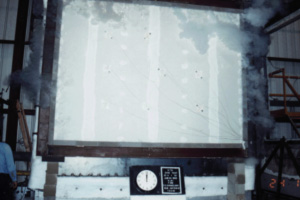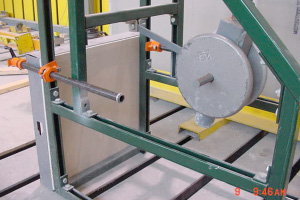System Performance Considerations - Interior
Interior Fire Performance
Fire resistive performance is a code requirement. The required level of resistance determined by the building code and is based on the occupancy of the intended structure, the height of the building, and the construction type. It is measured in hourly increments, with the most common ratings being one or two hours. The rating is based upon the performance of the whole system and not upon individual products or components. Cold-formed steel framed wall assemblies have successfully attained a four hour fire resistance rating. The test standard that is used to measure an assembly’s fire resistance is ASTM E119 Standard Test Methods for Fire Tests of Building Construction and Materials. The photograph to the left, taken from what is termed the unexposed side of the frame, depicts an actual fire test. More information on this subject is provided in the Technical Resources page on this Web site.
Also, the code provides requirements for controlling the surface burning characteristics of the wall cladding, and for the system’s combustibility. Where fire resistance is a function of the total system, surface burning characteristics and combustibility are based upon the performance of individual components acting independently of the other system components.
Surface burning characteristics of the wall cladding are determined by testing individual products according to ASTM E84 Standard Test Method for Surface Burning Characteristics of Building Materials. Each wall cladding product is tested individually by itself to determine how it will react to what is termed a “flame front”. The performance of the material is then compared to red oak flooring and cement board. The final number is not based upon units, but rather only reflects the comparison. In addition, the amount of smoke is measured to predict if the material will generate too much smoke, thereby impeding the ability to read exit signs. Recognition of a wall or ceiling element or component as being non-combustible is governed by testing per ASTM E136 Standard Test Method for Behavior of Materials in a Vertical Tube Furnace at 750o C. More information on this subject is provided in the Technical Resources section on this Web site.
The proper design of an interior wall and ceiling system includes the careful consideration of fire resistance, acoustical performance, moisture resistance, impact resistance, structural integrity, and desired aesthetics. In many instances, the interior system’s final design results from an iterative process which requires designers to prioritize system concerns. For example, acoustical considerations may take priority over moisture resistance concerns. In addition, wall height may impact stud depth, thickness and spacing. Modifications may influence the entire system’s sound transmission.
Interior Acoustical Performance
 To measure the acoustical performance of a wall system, a single number rating system has been established to rate how well the wall impedes the transmission of sound energy through the wall itself, and to uniformly compare the acoustical performance of one wall system to another. For wall systems the focus for acoustics is how well the wall impedes the transmission of sound energy through the wall itself. There is a single number rating system that has been established to compare the performance of one system to another. This rating system is called Sound Transmission Classification, or STC. The test procedure utilized to determine the classification is ASTM E90 Standard Test Method for Laboratory Measurement of Airborne Sound Transmission Loss of Building Partitions and Elements. The actual rating of the assembly based upon the results of the ASTM E90 tests is derived from ASTM E 413 Classification for Rating Sound Isolation. More information on this subject is provided in the Technical Resources section on this Web site.
To measure the acoustical performance of a wall system, a single number rating system has been established to rate how well the wall impedes the transmission of sound energy through the wall itself, and to uniformly compare the acoustical performance of one wall system to another. For wall systems the focus for acoustics is how well the wall impedes the transmission of sound energy through the wall itself. There is a single number rating system that has been established to compare the performance of one system to another. This rating system is called Sound Transmission Classification, or STC. The test procedure utilized to determine the classification is ASTM E90 Standard Test Method for Laboratory Measurement of Airborne Sound Transmission Loss of Building Partitions and Elements. The actual rating of the assembly based upon the results of the ASTM E90 tests is derived from ASTM E 413 Classification for Rating Sound Isolation. More information on this subject is provided in the Technical Resources section on this Web site.
Impact Resistance
 Wall cladding impact resistance (and durability), sometimes termed abuse resistance, is determined by testing wall cladding components per ASTM C1629 Standard Classification for Abuse-Resistant Nondecorated Interior Gypsum Panel Products and Fiber-Reinforced Cement Panels. This standard classification system consists of three levels of performance for which the panels may qualify. The test protocol examines the panels for what is termed hard and soft body impacts. The photo to the left shows a test panel clamped in front of a swinging ram (hard body). The ram drops a known distance with a known weight to determine the impact energy. The soft body test is performed similarly, but instead a leather bag filled with 60 lbs. of sand is employed to simulate the soft body. Both tests attempt to measure the amount of energy that is required to fracture the panel. A panel’s surface abrasion resistance and localized panel indentation is also measured. Surface abrasion is measured by scraping a wire brush with a known load back and forth (one cycle) across the surface of the panel. The number of cycles of the brush needed to gouge the surface to a predetermined depth is measured and recorded. Surface indentation is measured by dropping a small object of known weight from a standard height to the surface of the panel. The depth of the penetration is then measured and recorded.
Wall cladding impact resistance (and durability), sometimes termed abuse resistance, is determined by testing wall cladding components per ASTM C1629 Standard Classification for Abuse-Resistant Nondecorated Interior Gypsum Panel Products and Fiber-Reinforced Cement Panels. This standard classification system consists of three levels of performance for which the panels may qualify. The test protocol examines the panels for what is termed hard and soft body impacts. The photo to the left shows a test panel clamped in front of a swinging ram (hard body). The ram drops a known distance with a known weight to determine the impact energy. The soft body test is performed similarly, but instead a leather bag filled with 60 lbs. of sand is employed to simulate the soft body. Both tests attempt to measure the amount of energy that is required to fracture the panel. A panel’s surface abrasion resistance and localized panel indentation is also measured. Surface abrasion is measured by scraping a wire brush with a known load back and forth (one cycle) across the surface of the panel. The number of cycles of the brush needed to gouge the surface to a predetermined depth is measured and recorded. Surface indentation is measured by dropping a small object of known weight from a standard height to the surface of the panel. The depth of the penetration is then measured and recorded.
Interior Moisture Resistance
![]() Moisture resistance is the first system component that should be evaluated based upon the system’s intended environment. First, the material’s water sensitivity should be evaluated, i.e., how much the material degrades in the presence of moisture. Next, the material’s degree of water absorption and its inherent resistance to mold growth should be determined. Information provided by the manufacturer of the material will assist in determining these factors.
Moisture resistance is the first system component that should be evaluated based upon the system’s intended environment. First, the material’s water sensitivity should be evaluated, i.e., how much the material degrades in the presence of moisture. Next, the material’s degree of water absorption and its inherent resistance to mold growth should be determined. Information provided by the manufacturer of the material will assist in determining these factors.
The system’s environment, which can be dry, intermittent wet or wet, is important to evaluate because the intended environment will influence decisions made about individual components (cladding and finish) and the specific detailing required for each.
Structural Integrity
 Most interior partitions in a non-combustible building are considered nonstructural, meaning that the partitions are not designed to carry the loads imparted on the structure. Therefore, to determine the appropriate framing for interior partitions, information about wall height, finish materials’ deflection requirements, and any special loading conditions must be evaluated. For nonstructural applications, an assumed uniform lateral load, typically 5 psf, is placed upon the wall. This lateral loading will impact the required stud size and spacing as the wall gets higher. Additionally, a deflection limit, used to minimize the potential for finish cracking, is placed on the wall. This limit varies with the intended finish (e.g., drywall, plaster, or marble). For drywall and paint applications, the limit is set as a ratio to the height of the wall and is L/240. L represents the height of the wall (unsupported span of the stud) in inches. For plaster, the ratio limit is L/360. The Steel Framing Industry Association has a complete guide to assist the designer in selecting interior partition studs.
Most interior partitions in a non-combustible building are considered nonstructural, meaning that the partitions are not designed to carry the loads imparted on the structure. Therefore, to determine the appropriate framing for interior partitions, information about wall height, finish materials’ deflection requirements, and any special loading conditions must be evaluated. For nonstructural applications, an assumed uniform lateral load, typically 5 psf, is placed upon the wall. This lateral loading will impact the required stud size and spacing as the wall gets higher. Additionally, a deflection limit, used to minimize the potential for finish cracking, is placed on the wall. This limit varies with the intended finish (e.g., drywall, plaster, or marble). For drywall and paint applications, the limit is set as a ratio to the height of the wall and is L/240. L represents the height of the wall (unsupported span of the stud) in inches. For plaster, the ratio limit is L/360. The Steel Framing Industry Association has a complete guide to assist the designer in selecting interior partition studs.
Interior Aesthetics and Durability
What is the desired look of the finished wall or ceiling? Will there be a smooth colored finish, or one that is slightly textured? Will the surface receive vinyl wall covering? Will there be a stone or ceramic tile installed over the cladding? Knowing the desired outcome helps the designer to specify the best level of finish for the cladding. Working with the AWCI, The Gypsum Association has published guidelines to standardize these “levels of finish”. There are five different levels of finish specified that vary based upon the desired final appearance. These levels of finish (material and craftsmanship) effectively conceal panel joints and fasteners. Each level of finish is discussed in ASTM C840 Standard Specification for the Application and Finishing of Gypsum Board.
